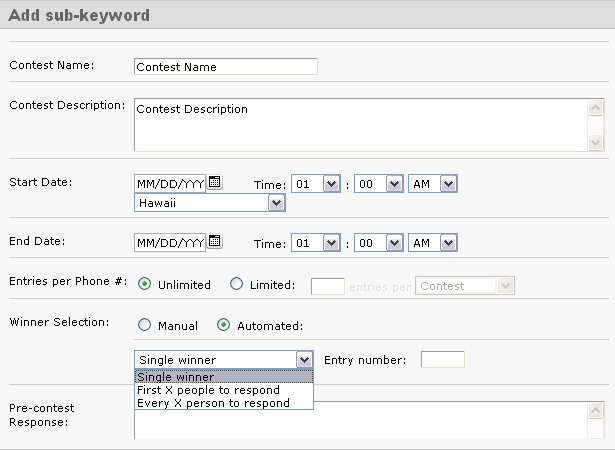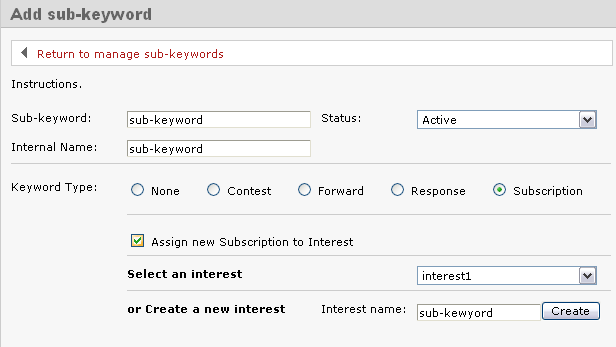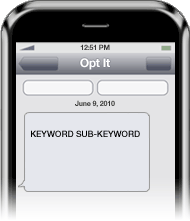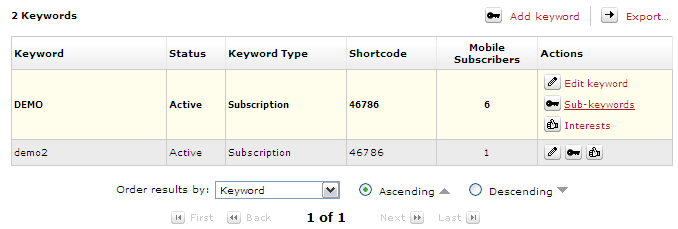Category Archives: How To…
August 2, 2010 by Jessica Zorawski
Now that you’re well versed on what a sub-keyword is and how to use it as a Subscription, we will continue our miniseries with detailed instructions on how to manage a sub-keyword type Contest.
Contest
Choosing the sub-keyword type Contest will provide you with a multitude of options to completely automate the Contest process.

Start by giving the Contest a name and description. This is solely for internal purposes and will help you utilize our reporting tools later on.
You can set the Start and End dates for your Contest, down to the minute. There is a setting to adjust time zones as well.
Next, chose the number of Entries per Phone you want admitted into the contest. Then, chose whether you want the Winner Selection to be Manual or Automated. If you select Automated, you can choose to have multiple winners. If you choose the Manual selection option, you can manually select the winner from the poll of available entrants.
The next five fields are the Pre-Contest response, Post-Contest response, General/Losing response, Winning response, and Already Entered response messages. All of these messages, if left blank, will not be sent out. However, it’s in your best interest to fill in at least some of these, especially if people will be joining your list for the first time so that they receive some sort of confirmation that they text in properly.
The language you use within these messages is up to you, however, we’d like to suggest some potential language that has worked well for others:
Pre-Contest Message
“Thank you for joining the ___ contest! We will notify you with the results shortly.”
*If a person texting in is NOT yet a member of the keyword, texting in for the contest does not add them to your keyword list. Consider offering them a way to join by adding “Reply [YOUR KEYWORD] to receive future promos & coupons”. This line can be added to any or all of the messages.
Post-Contest Message
“Thank you for participating in the ___ contest. Check back with us regularly as we love offering savings and coupons to our loyal customers!”
General/Losing Response
“Thanks for being a part of our __ contest. Unfortunately, you did not win this time, but feel free to try again next time!”
Winning Response
“Congrats- You WON!!!! Come to ____ & redeem your reward!”
Already Entered Response
“Thanks for texting in, but you are already entered in to this contest. We’ll notify you soon regarding the results!”
Last but not least, hit Save. Create awareness for your contest through your advertising and employees and sit back while Opt It Mobile 3.0 takes care of the contest!
Check back tomorrow for information on the Forward and Response type sub-keywords.
July 30, 2010 by Jessica Zorawski
For those of you bursting with anticipation for Part 2 on sub-keywords, the long, 24 hours wait is over: here’s the promised post explaining the popular sub-keyword type, Subscription.
If you followed all of the steps from yesterday’s post, telling you to go to Mobile> Manage Keywords> Sub Keywords> Add Sub Keyword and you chose the keyword type Subscription, then you are all set to begin:
Allow us to explain the difference between a sub-keyword and an interest and describe how they relate to each other. The purpose of choosing the sub-keyword type Subsciption is to sub categorize your list into specific target groups. Sub-keywords provide the functionality to sub categorize from an EXTERNAL perspective (think: CLIENT perspective); interests are the way to sub categorize from an INTERNAL Opt It Mobile 3.0 perspective. This means that when your customer texts in, they are saying “put me in this group within your software!”. Creating such a group WITHIN the software is the same as creating an “Interest”. You can create the sub-keyword and interest both at the same time- it’s real easy, see below:

Creating a Subscription Sub-Keyword
Within the Edit Sub Keyword screen, check the box that says Assign new Subscription to Interest and Create a New Interest with the same name as your sub-keyword, and then click Create. The reason you should make both the same name is because when you attempt to Send a Text Message, the system will ask you which Interest groups you want to send to, not which sub-keywords. Giving them both the same name saves a lot of confusion.
Next, you will have the ability to edit the Welcome Message, Web Form Verification, and Already Subscribed Message. Since sub-keywords are not separate groups from keywords, the message that members receive depends on whether they are already a member of the keyword or not. Simply put:
- If your member is NOT yet a part of the keyword and joins your sub-keyword, they will receive the Welcome Message
- If your member is already a part of the keyword and joins one sub-keyword, they will receive the Already Subscribed Message
- If your member is already a member of the keyword and a sub-keyword, they will receive the Already Subscribed Message
Keeping this in mind, we suggest that you choose Custom for the Already Subscribed Message and edit it to contain the same language as the Welcome Message (just copy and paste it) or change it to contain an offer. You want to make sure it doesn’t stay as “Ops! You’re already opted in…”, because this will confuse the end user.
Scroll down the Edit Sub Keyword page to add in a Response Message if you would like. This is a one-time message that will go out when someone joins the sub-keyword. It can be used in a variety of ways, from a digital business card to a mobile coupon. If you don’t want this message to go out, just leave it blank.
Last, choose if and where you want messages forwarded in the Subscription Forward option. You’ll have the option to create a Response Message that would go out after the forwarded message. For example, if you asked your members to respond to your message with information, you could use this message to thank them for the info. It doesn’t go out until the message is replied to. Like the other Response Message, if you leave it blank it doesn’t go out.
And there you have it! Check back tomorrow for detailed information on the keyword types Forward, Response, and Contest.
July 29, 2010 by Jessica Zorawski
About 90 percent of all Opt It customers ask, “What’s a sub-keyword?” We think it’s a great question and one you’ve probably asked yourself in the past. The following is the first of a mini-series of posts dedicated to explaining sub-keywords. These posts will give you information on how you can extend your keyword functionality to utilize all of the keyword types and increase the number of ways you can interact with your members.
Definition
Let’s start off by explaining what a sub-keyword is: it’s a second word that people text in to interact with your keyword in a different way. A sub-keyword gives you the ability to have your keyword act in a variety of different ways and to support multiple keyword types.
In order to interact with one of your sub-keywords, your customers would text your keyword, followed by a and a second word (the sub-keyword) of your choice. An example looks like this:

A sub-keyword is set up in the same way as a regular keyword in the software, meaning you choose which keyword type you want your sub-keyword to function as: Subscription, Response, Forward or Contest. Current members and new members alike are able to interact with the sub-keyword/s of their choice. After doing so, they’ll receive a message depending on the sub-keyword type.
When Should You Use a Sub-Keyword?
Each business will need to decide for itself how sub-keywords fit into their goals and desired results, but in general, using a sub-keyword is best when your goals are:
- To create categories within the main keyword
- For example- if your keyword is FOOD, your sub-keywords might be BREAKFAST, LUNCH & DINNER, so that you could send more targeted message to the people that enjoy a particular meal-time coupon over another.
- If you are a bar, your sub-keywords might be FRIDAY, SATURDAY, HIPHOP, etc.
- To market different locations
- If you have multiple locations with the same marketing plan, you can use sub-keywords to send out a specific message to a particular location if needed.
- To create sub groups that match your different target market segments
- You can create sub categories based on zip code, city name, neighborhood, etc.
- To run a contest
- Set up your sub-keyword as a contest to get the full functionality of a contest, and add a subscription keyword into your response to build your database
- To create a digital business card
- Make a sub-keyword type Response and allow your customers to text in for your contact information.
How to Set Up a Sub-Keyword
In order to set up a sub-keyword, log in to your Opt It account and hover over the Mobile option. Choose the first option, Manage Keyword. All of your keywords will display on the screen. Decide which keyword you want to create the sub-keywords under, and hover over that keyword. The field will expand to show three options under the Actions field; choose the Sub Keywords option.

The Sub-Keywords screen will appear. Hit Add Sub-Keyword on the top left of the screen. Enter a sub-keyword name and then choose the Keyword Type and fill out the fields associated with the sub-keyword type.
Check back tomorrow for detailed information on each sub-keyword type!
July 21, 2010 by Jessica Zorawski
One of the first questions we always hear from our clients is, how do we get people to opt in? Over the past 6 years of watching what works and what doesn’t, we’re happy to share our insights on how to effectively grow your recipient list:
Incentives: You must offer your customers an incentive, or prize, for giving you their cell phone number. People are weary to give away their number, so offering them a discount, or something for free, motivates them to join.
- Choose the right incentive -the difference between 5% and 50% off is huge. It’s up to you how much you’re willing to give away to get someone to opt-in. Just ask yourself, “How much is someone’s cell phone number worth to me?” Remember, if the offer isn’t enticing, people won’t sign up. We’ve found that the better the incentive, the faster your list size will grow.
- For Customers with Established Lists -use our reporting tool to check the time of day that you have the greatest amount of opt- in’s. For example, if you’re a restaurant owner and the majority of your members opt in at 1 PM, offer a special on a lunch item. This may seem obvious, but we’ have seen too many examples of a company pushing a certain item and not listening to what their customers really wanted. Using our analytics allows you to zero in on what your customers are looking for, getting you the biggest return on your investment.
Contests: In conjunction with offering a guaranteed incentive, create a contest that your subscribers will automatically be enrolled in if they sign up. Adding this incentive gives customers more reason to opt-in. Make the contest weekly or monthly to keep it top of mind with your members.
Illusion of Exclusivity: Make sure your customers know that they will only receive the best deals available at your location via text message. The language you use in your signage for people to opt-in should portray this exclusivity.
Be Clear: Tell people how many messages you plan on sending them. If you include a short line at the bottom of signage that says, “we will only send you 4-6 messages a month”, people will feel more in control of what they are signing up for.
BOLD and Capitalize your KEYWORD and SHORT CODE: Not everyone understands keywords and short codes just yet, so giving clear instructions on how to join your list is very important. For example, if your keyword is “coupon”, the main line of your signage would read: “Text COUPON to 46786” This will effectively grab the attention of your customers.
No Surprises: Let people know that message and data rates may apply.
Get Your Employees on Board: Make sure your personnel are not just aware but actually educated and excited about your text message marketing campaign. Your employees are the face of your company and the primary contact for your customers. Employees need to be able to help people sign-up from their phones, as well as to promote the list. Turn it into a contest for them and watch your list grow twice as fast.
Change is good: Change your incentive and the way you present your text campaign to your customers periodically so that you can capture a more diverse group of people to join your list. Your offer for X% off may get some of your clients interested, but if next month you are giving away a free ____, you might get an entirely different crowd to opt-in.
Get creative: Don’t just rely on a sign for people to join. Make t-shirts for your staff with a call-to-action to sign up, create a monthly contest for your staff encouraging them to get most members to sign up, etc.
An example layout of a sign that incorporates all of these ideas is as follows:
“Text SAMPLE to 46786 to join our exclusive mobile group”
“You will automatically receive a FREE _____!”
“Also, you will automatically be put in a drawing to win a FREE ____!”
Msg & Data Rates May Apply. To Opt Out Reply STOP
We will only send you 4-6 exclusive messages a month.
All of these ideas can and should be incorporated into all of your mediums for marketing the list. Try out these simple ideas and keep us posted as your campaign really takes off!



